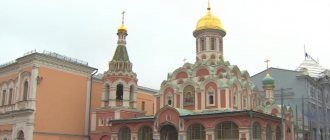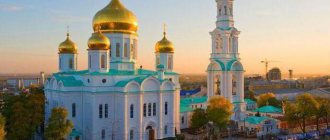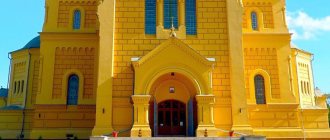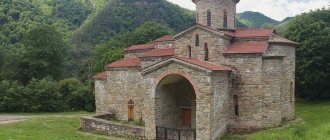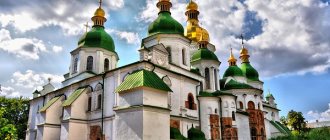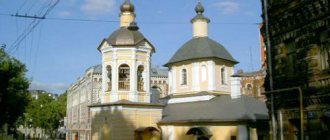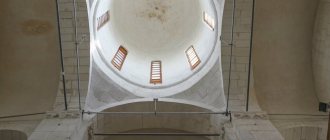This coming Sunday, May 2, at 10:10 on the MIR TV channel
watch the series “Father”, which will talk about the unusual ways people come to faith. This is the story of a former sailor who came to his native village and found himself caught up in the common cause of his fellow villagers - the restoration of a temple destroyed under Soviet rule. This changes the life of the main character, who was previously far from faith, so much that he eventually decides to become a priest himself.
Watch the series “Father” on May 2 at 10:10 on the MIR TV channel.
It’s not only in the movies that such amazing things happen. Nowadays, there are quite a few people who, on their vacations or vacations, are engaged in the restoration of dilapidated Orthodox churches. There are even those who, as in the series, change their entire established lives and remain to live where they are needed most. What motivates these people?
“The scouts came and stayed that way”
The Church of the Nativity of the Blessed Virgin Mary in Izborsk, Pskov region, is not very large, made of stone. In the 90s of the last century, it was in disrepair: not exactly destroyed, but badly damaged, and a birch tree grew from the dome. Its restoration has been going on since 1997, although very slowly. At first, only a few local men were involved in this. Later, one of them was ordained and became a deacon in the same church, and the other two became sextons. At that time, only they and the elderly priest, Archimandrite Nikodim Mironov, who had previously been the confessor of the Vilnius Monastery of the Holy Spirit, were involved in the temple. Now he has already died, having entrusted the care of the temple to a young priest, Father Alexei from another regional church.
“Last summer, almost by chance, through acquaintances, I ended up as a voluntary assistant in the detachment that was engaged in the restoration of this church. It was so important to local residents because it was founded in the 17th century by the Monk Serapion of Izborsk, an unusually revered priest who, as a result of his spiritual activity, began to be considered almost a saint by local residents. His relics rest under this temple. Therefore, modern residents of Izborsk really wanted to restore this particular temple in memory of him, especially since it is closely connected with the Virgin Mary healing springs, which still flow from the ground,” says volunteer, master’s student at Moscow State University Nikita Chistyakov
.
As Nikita Chistyakov told a MIR 24 correspondent, the work picked up significantly after a group of teenage scouts arrived in Izborsk in 2001. They were looking for a place for their tent camp. In addition, they needed a church nearby so they could attend services and receive communion on Sundays. Having discovered a half-restored temple in Izborsk, they asked permission to take part in the work.
Since then, scout troops have been working one or two shifts every summer to restore this temple, and they have really done a lot there. Local authorities also got involved. The former scouts from the very first detachment are now 29-30 years old, and almost all of them still visit Izborsk, and continue to restore this temple together with the new generation of scouts.
Now we are just recruiting teenagers for the detachment that will go there this year, unless, of course, all camps are canceled this year. Moscow guys and scouts from Pskov will go.
Donations to the temple
Changing the situation in the field of charitable assistance to our church for the better can only be done by the common efforts of the entire Orthodox society, which is not indifferent to the state of affairs of Christianity in general and lost shrines in particular. Today there is a positive trend regarding the restoration and restoration of abandoned or destroyed churches and temples, and we sincerely hope that this trend will only grow.
Help the temple - join the noble cause of reviving shrines! Let's set a worthy example for our descendants, who will see the fruits of our activities for many, many years after us.
ANO "Wonderful Capital" sincerely thanks all caring and kind people! We are confident that thanks to your help, together we will be able to help and restore a large number of churches in need.
“I challenged myself and decided to try at least once”
Photo: Ekaterina Litvinenko, Irina Rakhmanina, Svetlana Gorodova and some others from the archives of the “Heaven is Calling” team“Why do people go? Firstly, restoring the temple is God’s work; they are driven by a sense of duty. The second is a friendly company, the opportunity to live in nature, romance, special relationships that are built within the team: very warm, human relationships,” says Svetlana Gorodova
, which has been participating in expeditions to restore wooden churches in the Russian North for three years now. In those parts there are more than 600 unique wooden temples and monuments of folk architecture. Most of them are in poor condition.
“There is a huge organization of people who work within the framework of the project “Common Cause. Revival of wooden temples of the North." There are several detachments there, and the headquarters of this organization is located in the Church of Seraphim of Sarov in Medvedkovo,” says Svetlana. – You can come there and declare your desire to participate in the expedition. We mainly need men with working skills: carpenters, builders, installers. Architects are desperately needed. I traveled as a photojournalist, plus I kept a report on the expedition on social networks and helped in the kitchen. There was always something to be done there, and there was always enough work.”
Photo: Ekaterina Litvinenko, Irina Rakhmanina, Svetlana Gorodova and some others from the archives of the “Heaven is Calling” teamAll projects are prepared in advance in Moscow, and if necessary, they are approved by the Ministry of Culture. There are architects and supervisors who lead the project, outline the work plan and conduct on-site inspections of their implementation.
“I’m a city resident myself, and when I went on my first trip, I honestly thought it would be a little hard for me,” says Svetlana. “But I challenged myself and decided to try at least once. And the second time I was just waiting for the next expedition! It turned out that it was possible to live in a tent, to cope with mosquitoes, and to swim either in the river or in the bathhouse. And living in nature is great: in the evening we sang songs with a guitar around the fire, chatted and talked.”
Now within the framework of the project “Common Cause. Revival of wooden temples of the North”, dozens of expeditions are sent to those regions every year, in which hundreds of volunteers from Moscow and other Russian cities take part. Over the 13 years of the project’s existence, more than 70 expeditions took place, during which 360 temples and chapels were examined, and emergency restoration work was carried out in 153 of them. In the summer of 1919, work was carried out in 30 churches and chapels. 750 volunteers took part in these expeditions.
“Whenever we work, we participate in services, and this is the most important thing,” says Svetlana. “Everyone confesses there, takes communion, we sing in chorus, and it turns out very friendly and soulful. These trips unusually bring us together, and then we become friends, help each other, communicate. We have a general chat on WhatsApp, in which we constantly correspond, publish news, and plan new trips.”
“We simply make great dreams come true”
Photo: Ekaterina Litvinenko, Irina Rakhmanina, Svetlana Gorodova and some others from the archives of the “Heaven is Calling” team“Everyone has their own reasons for participating in this common cause,” the commander of the “Sky is Calling” expeditions within the framework of the “Common Cause” project told a MIR 24 correspondent. Revival of wooden churches of the Russian North" priest Dmitry Nikolaev
. – Someone wants to serve, someone wants to be distracted, someone wants adventure, someone wants not just to go on a hike, but to go to the same conditions, but for a worthy cause. In any case, people travel with the same thoughts, and there they encounter completely different, deeper meanings. They get experiences that they didn't even know existed. Because there the unity of man and the holy cause occurs. And, of course, all this is under the hand of the Lord himself. The connection with God on such trips is very tangible. You see, there is an environment of constant doing. People don't sit, don't meditate, don't think about what they sense or feel. People are constantly doing something together - for the sake of God, for the sake of Christ! Being inside this whole process, they are imbued with grace. When they drove for the first time, they did not think that this would happen. They just didn't know it could happen."
According to Father Dmitry, people come very different. There are also non-believers, they change. “I had 12 trips in five years,” he says. “And on every trip there are people who confess and receive communion for the first time right there, in the churches being restored. People who, thanks to these trips, discover the Church. There are plenty of miracles there. Something in us changes forever, we become a little different after the expedition. And we are waiting for new trips. After all, something new is discovered every time. Any such trip does not pass without a trace.”
Photo: Ekaterina Litvinenko, Irina Rakhmanina, Svetlana Gorodova and some others from the archives of the “Heaven is Calling” teamFather Dmitry Nikolaev says that during his team’s trips, four families were gradually created. The first expedition in 2013 included 10 people. And then the number grew all the time, and last year there were already 55 participants in the expedition. Among them are those who were on the very first expeditions.
“For the last two years we have had very large facilities,” says the priest. – We worked very quickly and very fruitfully. Miracles actually happened: in two weeks, an emergency church was transformed into a normally functioning one, in which we served liturgy, children were baptized. But there were ruins! There was no roof, no floors, there was nothing!”
“Strictly speaking, what we do is called conservation, something temporary, but we have a tradition of making it last for a very long time. It is not known in what year or century restorers will appear in these churches,” says the priest.
Photo: Ekaterina Litvinenko, Irina Rakhmanina, Svetlana Gorodova and some others from the archives of the “Heaven is Calling” teamAll this is done with the personal money of volunteers and with the funds that the whole world manages to collect on crowdfunding platforms. “We collect specifically, according to the estimate. Now, for example, we are preparing a large project, and as soon as it is finally approved and an estimate has been created, we will begin to raise funds.
The Russian North is addictive. Why do people go? The soul asks for something that it does not find in the metropolis. Because life in a metropolis is unnatural. A person needs to work on the earth, a person needs to breathe, a person needs to look into the distance. And when a person escapes from here and finds himself there, he begins to look at the world with clear eyes, and this has a stunning effect on him!
“Remember the movie “The Courier”? - says Father Dmitry. – There, the main character gave his friend a coat that he had dreamed of and wished him to dream of something great. So, going north, we make great dreams come true.”
How a village teacher restored a temple
To prevent her students from falling asleep, she decided to restore the village temple. As a result, she saved both the students, the temple, and the entire village. And most importantly, she found faith herself. I met teacher Vera Vasilyevna Reutova in the village of Aramashevo, Sverdlovsk region. Despite many concerns, Vera Vasilievna agreed to talk to me.
Vera Vasilievna Reutova
“We are in a church that is 385 years old, it is named in honor of the Kazan Icon of the Mother of God,” Vera Vasilievna begins to tell as we enter the refectory.
Beautiful singing can be heard from the chapel, through the door crack you can see a rich iconostasis, images along all the walls, about 40 parishioners, from the window you can see the endless snow-covered expanses and the river, tightly covered with ice, snaked away to the horizon.
– The temple stands on a high rock, its height is 43 meters. I myself am a tourist with 47 years of experience, so I have already measured and researched everything here.
Vera Vasilyevna talks about the history of the church in the intonations of a tour guide. She’s so used to it, and besides, she’s noticeably worried: journalists rarely come to their village 130 kilometers from Yekaterinburg.
Temple in honor of the Kazan Icon of the Mother of God, Aramashevo village. Modern look
– Our temple was built by nomads. They wandered from place to place for the time being, but when they came to this high bank and saw the extraordinary beauty, they immediately decided to stop here for good. The first thing they built was not a home for themselves, but a wooden church. Why was it called Kazanskaya? The day they arrived here in 1631 was Kazan Day, July 8th according to the old style, and they believed that Our Lady Herself had brought them to this place. Moreover, in one of the carts there was Her icon.
– When was the stone church built?
– The white stone temple – in 1800. By that time the settlement had already grown. The Perm Chronicle even says: “And they erected a beautiful white stone church on the high bank of the Rezh River.” The church is amazing in its location: it is still visible from all four sides, no matter where you approach Aramashevo.
- But the revolution broke out. I read on the Internet that the temple was closed only in 1929, that is, it still held out for a long time under the Bolsheviks. However, this is typical for many churches in the Urals. It was as if the Bolsheviks had been accumulating anger within themselves all these years after the Civil War, so that later they could deal with the churches as harshly as possible. What was the fate of your temple?
The bell fell from an 80-meter height. Everyone thought: he crashed. But there wasn't even a crack. And then everyone got on their knees
“They treated him very harshly.” Indeed, in 1929, the descendants of those who built this temple came here as destroyers. Of course, there were not many of them - two dozen people, but they did such a thing here! And before that, they herded all the residents to the temple, lit fires, threw icons and books into the fires. Then they brought draft horses here. And each draft horse was equivalent to a small tractor. Twelve horses were harnessed - our long-liver Anna Yakovlevna Telegina, who saw all this as a six-year-old child, told me this. She cried bitterly when she remembered: the Bolsheviks climbed the bell tower, threw ropes over it, tied it to the horses and began to beat them with whips. The horses rushed at once and pulled down the bell tower. And together with its top, a large messenger bell fell to the ground. He fell from almost 80 meters height. Everyone thought: he crashed. But the bell turned out to be intact; they couldn’t even find a crack. At that moment, all the residents knelt before the destroyers and began to cry. And, imagine, they didn’t melt their hearts. Then something terrible happened. The barbarians tied the bell to the horses, brought the horses to the very edge of the cliff and pushed the bell into the river. This bell has not yet been found.
View of the village from the bell tower
– But this is not the sea, is it difficult to find a bell here?
- What are you talking about! Even divers came here for two years in a row. They say that the silt is very deep here. I think the bell left without a trace from the people who dealt with it so cruelly.
After the defeat, our church was destroyed for eight decades. At first it was a house of culture. A stage was set up in the altar. Then the building burned down. And after that, no one needed her anymore.
“I remember driving past this temple in the mid-2000s. It was very destroyed, although it looked majestic. But I couldn’t even think that it would be restored, it seemed like a miracle. Have you always wanted to restore it? What prompted you to do this?
To prevent my students from falling asleep, I decided to distract them - I called them to restore the temple
– The fact is that I am a teacher of Russian language and literature; I worked at a local school for 30 years. And she was the head teacher of educational work, and was involved in tourism, and local history. That’s why all the village children grew up before my eyes. I remember everyone. And it so happened that in the 1990s, all my students, my boys - they were actually uncles and fathers of families, many with gray hair - were all left without work. Dashing years. Then our entire basic farm was destroyed - the best seed-growing state farm in the region. And so, so that my guys wouldn’t get drunk, and then many would go down this path, I decided to distract them by the fact that we began to restore the temple.
Temple in honor of the Kazan Icon of the Mother of God, Aramashevo village. Photo before June 2005
– Why was the temple chosen to distract the villagers? There were still many destroyed buildings in the village.
– There was a lot of work to be done here. Endless edge. And moreover, it could be done, so to speak, for the glory of God. Stack the fallen bricks, mow them around - everything was covered in weeds and nettles. A lot of work was like this: take it, carry it, give it.
– Did the villagers agree right away? Is this out of respect for you? Or a thirst for faith?
– I don’t know this, but when I invited them – and I just wrote an ad – 63 people came. Moreover, the third part came with children. And I remember we sorted the bricks - we took out the bad ones and left the good ones for the future - then we sat down on these bricks and already realized that we would not leave here. I don’t even know why, it’s inexplicable, only the Lord can tell how He led us.
- We'll come back to this later. Were you yourself a church member at that time? How did you come to God?
– I had a believing grandmother. And she instilled in me, if not deep faith, but at least the fact that we never did anything inappropriate, we knew: there is a Judge over us. But I have never been a church member, no.
– When did the moment come after which you consciously came to faith?
- And it happened in this temple. When we started to restore it, we didn’t take on the whole church right away. We didn't have any money. Father was not there. We ourselves showed the initiative – from below. Therefore, we decided to restore only one chapel. As soon as we did this, I invited Father Moses and the brethren from the Monastery of the New Martyrs of Russia on Mezhnaya. And when they sang in this small altar - after more than 80 years, prayer began to sound here again (Crying), and it was the Nativity of Christ, January 7, 2006 - you know, we all hugged each other and cried with happiness. In our village, everything was destroyed for eight years, and now we ourselves have returned a piece of spirituality. It was from that moment that I realized that I would never leave this temple again. No matter what they say about me. And some people condemned me, they said that I had gone crazy, because the temple was calling on everyone to restore it. And at that time no one had money, and they were still perplexed: how is it that in the best years the church was not restored, but here...
Temple in honor of the Kazan Icon of the Mother of God, Aramashevo village. Stages of destruction and restoration
– Yes, indeed, you experienced a wonderful Christmas then. How did the events unfold then? Money for restoration did not fall from the sky.
– And then icons began to come to us. Yes, not easy, but from this temple, rescued in 1929 by brave people. One of the icons is a life-size icon of John the Evangelist. The deacon saved her. The deacon's house has been preserved; the residents of Yekaterinburg, a husband and wife, bought it as a dacha. They began to tidy up the attic, and suddenly a holy face looked out at them from the garbage. Where will you put it at home? They brought it to the temple. My husband is a labor teacher. The most important assistant. I couldn't do anything here without him. He made a stand, and we placed this icon. And they didn’t know what kind of icon it was.
“This is the most fateful sign,” says the bishop, “if the icon returns to its temple. She will work wonders"
But then the incredible happened. Bishop Vikenty, in those years the Archbishop of Yekaterinburg and Verkhoturye, came to visit us. He was traveling from Alapaevsk, and there the priests sang all his ears about our temple. They say we are surprised: the Armashevites haven’t been paid for eight years, they don’t have their own priest, but they went to restore the temple! Vladyka, apparently, decided to see such miracles himself. And when he entered those doors, followed by a large retinue, you know, how I shuddered! I had no idea how to handle him. And out of fear she began to tell him: behold, an icon was brought to us the other day... He suddenly took off his headdress, knelt down and prayed on his knees for about ten minutes, then he said: “This is the most fateful sign if an icon from the same comes to the temple temple. She will perform miracles in gratitude for her return to her temple.”
Well, isn't this a miracle?! Where did we start? From the ruins! And now look at our temple!
Temple in honor of the Kazan Icon of the Mother of God, Aramashevo village. Interior decoration
– Did the diocese help you restore the temple?
I didn’t even think about going to the Academy of Architecture. God's providence directed me there
- No, there’s another miracle here. I went to Yekaterinburg, visited the diocese, of course. But they say: “You have started a good deed. As soon as you restore it, we will register you.” That's all. I, upset, then ride the tram past the Academy of Architecture. And I had photographs of the temple with me. And I walked into this academy - you won’t believe it, by God’s Providence, as if He had directed my steps there...
– You weren’t going there initially?
- Of course not! But I read the sign: “Architectural Academy.” I thought: they will at least tell me what to do next. I am the simplicity of my soul! Of course, the guard won't let me in. And I see: phone numbers are written, and the phone number of the rector of the academy, Alexander Alexandrovich Starikov. She turned away from the guard, dialed this number... and he picked up. The main thing is that I raised it myself! The secretary was not there at that moment; she definitely would not have allowed me to see him. I scream into the phone with excitement: “I’m from the village of Aramashevo, I need your help!” Starikov says: “Come in.” It turned out - he told me later - the rector once vacationed in our area and often went to this temple on foot. He says: “My soul ached that the temple was being destroyed in such a beautiful place.” He immediately sent sixth year students to me. We worked well with them. Then he sent his teachers. They made a project for the restoration of the temple. And this is how the work went on through the Providence of God.
Soon we got a benefactor from Yekaterinburg, a not poor man, also a churchgoer, who built a house in our village. He helped us a lot. At first, only his funds were used for restoration, then others joined in, including heads of enterprises from Yekaterinburg. They all did a very great job. We would never lay a warm floor, we would never plaster such a huge height.
– How many years did it take to restore it from start to finish?
– The eleventh year is already over.
Local history museum of the village of Aramashevo
– They also told me that you opened a museum in the village, restored a holy spring and began conducting excursions, and invested the proceeds in restoration... Do you understand that you are a heroine? What example are you for the country?
– I don’t think I’m great. I think that each of us is led by the Lord, we do not go of our own free will, we were put on the path, like foolish children, and told: “Go there.” After all, by that time I had already retired, I was sitting warm in the school museum, I could probably have stayed there. But you have already heard that I took a different path.
– Do your students who helped you go to church?
– I must say honestly: they are not regulars at the temple. But these are people who will never do anything bad in this life, I guarantee this, because they are imbued with... I won’t say that they are imbued with faith, but with goodness and spirituality. However, they can sometimes be seen at services. Many people are already coming with their grandchildren.
Temple in honor of the Kazan Icon of the Mother of God, Aramashevo village. Modern look
– And my last question will be about what is happening in the world now. You know what threats hang over Russia. Here you are, living in the Russian outback, one might say in the heart of the country, how do you assess everything that is happening? Is there hope?
Our unity saved the temple, conciliarity. This will save us all
– It is by hope that Russian people live, I think. Faith, hope and love for others. These are the three hypostases on which our Russia has always rested. Why should we betray them and sell them now? No! I don’t like loud phrases, but look at this. We live in a village, we all know each other, we cannot refuse each other. And due to this, among other things, we restored the temple. After all, not only my students came later, but also my 90-year-old grandparents - they remembered the temple was still in operation. When we began to restore it, they believed that they would see it again in their lifetime. And they helped as much as they could. It was our unity that saved the temple. Conciliarity. This, it seems to me, will save us all.
“Such a deep and interesting world has opened up to us!”
From the archive of Nadezhda PetrovaAnd one more story that changed the fate of a woman who started by painting the temple and remained to live at the temple forever. The Church of St. Nicholas the Wonderworker in the village of Vasilkovo, Kuvshinovsky district, Tver region, is a large stone temple built in the first half of the 19th century. “By our time, from an architectural point of view, it was generally in good condition, but the interior decoration had fallen into complete disrepair. - says Nadezhda Petrova, singing in the choir of this temple. “In the thirties, its walls were painted with rough dark paints. Our priest, Father Dmitry Volgin, is an artist, and, of course, he could not tolerate this, and the parishioners were unhappy. Together they wanted to repair and renovate the temple.”
It was not possible to officially restore it, but local authorities asked for repairs to the temple. The priest told them, if you want us to repair the temple ourselves, then send me young people who can enthusiastically participate in this. “That’s how my friend and I found out about it through friends,” says Nadezhda. “And so we dropped everything and came.” Since we are artists, when we became acquainted with the world of icons, such a deep and interesting world opened up to us that we wanted to enter it through some kind of activity. Eventually, a small team gathered around the temple to work on its restoration. They lived near the temple and painted it. One very good artist, icon painter Alexey Vronsky, worked with us. Father also painted the temple, and we mainly worked on the ornaments. At that time, a large number of young people came there and replaced each other. And all this work was incredibly inspired. We painted the entire temple in two years. I and a few other people lived permanently, the rest came when they could. There are several houses and a gatehouse near the temple - our small community lived there. And this community still exists, although almost everyone from that composition has left, but it is replenished with other people. Only I continue to live at the temple.”
Then a new job appeared. Kuvshinovo did not have its own church, and residents had a long way to get to the village of Vasilkovo. At first, local authorities gave away an old wooden building - a former kindergarten - for the temple. It was cleared, repaired and converted into a church. But then two fires happened one after another, and this building burned down.
Photo: from the archive of Nadezhda Petrova“Then we began to build a wooden temple in the style of ancient wooden Russian architecture. - says Nadezhda. – The drawings for this project were made by the architect, the spiritual daughter of our priest. And, of course, also selflessly, as we all worked. We didn’t have rich sponsors, so it took us a long time to build the church in honor of St. Ambrose of Optina – 10 years. Now there is already an active temple life there.”
We gradually made an iconostasis, stained glass windows, and carved icons. Our father, Father Dmitry Volgin, serves there and decorates it to the best of his ability. Now we have made a baptismal sanctuary in the lower part of the temple: we have installed a large font in the shape of a cross, and we are finishing the paintings for the walls. There is enough work.
There really is a lot of work, and there is still enough for our lifetime. With summer ahead, restoration projects will pick up speed again. Expedition teams are already being formed. Anyone who wants to participate in this business can make themselves known by finding a project they like on the Internet. Or, if you don’t yet have the courage to participate with your own work, then you can help with money: donations are accepted, and information about fundraising is not at all difficult to find.
